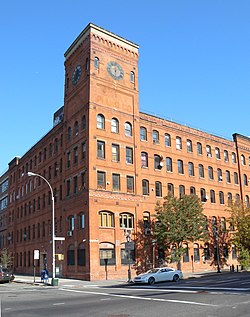Port Morris, Bronx
| Port Morris | |
|---|---|
| Neighborhood of The Bronx | |

The Clock Tower, former factory now serving residential and commercial tenants
|
|
| Location in New York City | |
| Coordinates: 40°48′05″N 73°54′35″W / 40.8015°N 73.9096°WCoordinates: 40°48′05″N 73°54′35″W / 40.8015°N 73.9096°W | |
| Country |
|
| State |
|
| City |
|
| Borough |
|
| Area | |
| • Total | 1.92 km2 (0.742 sq mi) |
| Population (2011) | |
| • Total | 3,523 |
| • Density | 1,800/km2 (4,700/sq mi) |
| Economics | |
| • Median income | $38,834 |
| Ethnicity | |
| • Hispanic and Latino Americans | 72.3% |
| • African-American | 24.7% |
| • White | 1.7% |
| • Asian | 0.4% |
| • Others | 1% |
| ZIP codes | 10454 |
| Area code | 718, 347, 646 |
Port Morris is a mixed use, primarily industrial neighborhood geographically located in the southwest Bronx, New York City. The neighborhood is part of Bronx Community Board 1. Its boundaries are the Major Deegan Expressway and Bruckner Expressway to the north, East 149th Street to the east, the East River to the southeast, the Bronx Kill to the south, and the Harlem River to the west. Its ZIP code is 10454. The neighborhood is served by the NYPD's 40th Precinct.
Oak Point, the southern tip of the South Bronx is in Port Morris. The area is also traversed by the Bruckner Expressway, a major freeway. Most of the neighborhood is within walking distance from the Cypress Avenue station of the IRT Pelham Line (6 train).
Port Morris has a population of around 3,523. The neighborhood predominately consists of Latin Americans (primarily Puerto Rican), African Americans as well as a small white population concentrated mainly in the western portion of Bruckner Boulevard. Almost half of the population lives below the federal poverty line and receives public assistance (TANF, Home Relief, Supplemental Security Income, and Medicaid). The median income is significantly higher than that of other South Bronx neighborhoods. This is likely due to recent rezoning to increase commercial and residential activity in the area.
...
Wikipedia



